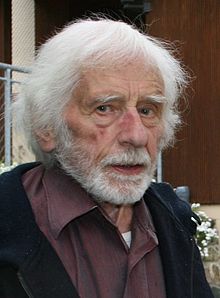Alois Spichtig
Alois Spichtig (born March 25, 1927 in Sachseln ; † July 24, 2014 there ) was a Swiss graphic artist and sculptor . He was considered to be “modest in nature and strong in expression”.
Life
Spichtig was born and raised in the hamlet of Edisried near Sachseln. In the workshop of his father and grandfather he learned how to work with wood and completed an apprenticeship as a white cooper . He was an intern at the Lucerne School of Applied Arts and continued his education during a three-month stay in Paris. At a young age he created the first grave marks in wood and began working in stone with a sculptor friend of his. Ultimately, he found his life's task in the design of historical and modern church interiors.
When Kurdish refugees were to be deported by police force in Obwalden in the 1990s , Alois Spichtig and his wife Margit Spichtig went on a hunger strike in solidarity with them. After conflicts during deportation, Spichtig returned an order from the canton of Obwalden to mark the 700th anniversary of the Swiss Confederation in protest : he sank a large stone cross with the preamble of the Federal Constitution he had made near the Ranft chapel in Melchaa in protest . Only much later did the cross find its place at the Sachsler church .
plant
Spichtig has artistically designed over 40 churches and chapels throughout Switzerland, including 15 liturgical rooms in his home canton of Obwalden. Alois Spichtig's work was strongly anchored in his homeland and was particularly inspired by the state saint Niklaus von Flüe (brother Klaus). Spichtig dealt intensively with his visions. This discussion has shaped his entire work. Spichtig was one of the initiators of the Brother Klaus Museum in Sachseln and designed the permanent exhibition that was shown from 1976 to 2011. From the founding of the museum in 1976 to 1992 he was in charge of the museum. The highlight of this time was the exhibition "Niklaus von Flüe 1981": Alois Spichtig brought 30 important Swiss artists to Obwalden at the time.
In addition to his sculptural work, Alois Spichtig also created woodcuts . One of his outstanding works is the Way of the Cross in the Church of St. Mary in Bern . Instead of the usual 14 stations, he summarized the passion of Jesus in five large-format reliefs. Other outstanding works are:
- Wooden Madonna in the crypt of the Church of Our Lady in Zurich (1999)
- Ecumenical prayer room in Elia Monastery, Humlikon
- Reflection room of the Alpnach parish center , opened in 1995
- Labyrinth in the St. Luzi crypt, Chur
- Celebration altar of the parish and pilgrimage church in Sachseln , 1976
- Interior design of the chapel of St. Anna on the Älggi-Alp in Sachseln
- Brother Klaus statue, designed as a relief, Brother Klaus pilgrimage church in Au- Wädenswil
- Cloud relief in the crypt of the Catholic parish of St. Peter and Paul, Winterthur
- House chapel in St. Dorothea's house in Flüeli-Ranft
- House chapel in the Hotel and Education Center Matt in Schwarzenberg
Awards
- 1996 Award of recognition from the Heinrich Federer Foundation
- 2010 Obwalden Culture Prize
Work edition
- with Margit Spichtig: Nikolaus von Flüe, enlightened night , with woodcuts to his visions, Herder, Freiburg im Breisgau 1981, ISBN 3-451-07852-X (= herd library 852, contains among others: Nikolaus von Flüe, accesses to a saint by Gertrude and Thomas Sartory. Reflections on the inner path by Margrit Spichtig).
Web links
- Literature by and about Alois Spichtig in the catalog of the German National Library
- Spichtig, Alois. In: Sikart
- The design of the liturgical space, presentation of the work of Alois Spichtig (PDF, 233 kB) Detailed article in the Obwalden Parish Gazette, No. 18, 2007
literature
- Marbeth Reif: "Miär are nice team" . In: Christof Hirtler (photographs); Heidy Gasser , Marbeth Reif, Sabi Zurgilgen , Peter Ming, Hanspeter Niederberger (texts): Images of people. Portraits of Obwalden residents. Landenberg Verlag, Sarnen 1992, pp. 70-79
Individual evidence
- ↑ Church interior designer Alois Spichtig died at the age of 87. kipa-apic.ch of July 27, 2014
- ↑ a b Romano Cuonz : He made Brother Klaus visible. In: Neue Obwaldner Zeitung, July 28, 2014, p. 10.
- ↑ The way of Jesus becomes the way of faith information page on the internet portal of the Catholic Church in Bern, accessed on May 17, 2010
- ↑ Alois Spichtig receives Obwalden Culture Prize (PDF) Media release of the canton of Obwalden from January 21, 2010, accessed on January 20, 2016
- ↑ Obwaldner Kulturpreis goes to Alois Spichtig Article in the Neue Obwaldner Zeitung of January 21, 2010
| personal data | |
|---|---|
| SURNAME | Spichtig, Alois |
| BRIEF DESCRIPTION | Swiss graphic artist and sculptor |
| DATE OF BIRTH | March 25, 1927 |
| PLACE OF BIRTH | Sachseln |
| DATE OF DEATH | July 24, 2014 |
| Place of death | Sachseln |
